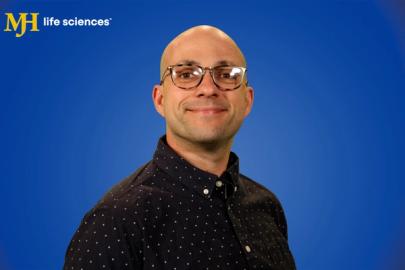- About Us
- Advertise / Support
- Editorial Board
- Contact Us
- CancerNetwork.com
- TargetedOnc.com
- OncLive.com
- OncNursingNews.com
- Terms & Conditions
- Privacy
- Do Not Sell My Information
- Washington My Health My Data
© 2025 MJH Life Sciences™ and CURE - Oncology & Cancer News for Patients & Caregivers. All rights reserved.
Stage 1 Testicular Cancer: A Patient Education Overview

A nationally-published, award-winning journalist, Alex Biese joined the CURE team as an assistant managing editor in April 2023. Prior to that, Alex's work was published in outlets including the Chicago Sun-Times, MTV.com, USA TODAY and the Press of Atlantic City. Alex is a member of NLGJA: The Association of LGBTQ+ Journalists, and also performs at the Jersey Shore with the acoustic jam band Somewhat Relative.
From diagnosis to treatment, here is what patients need to know about stage 1 testicular cancer.
Testicular cancer is an abnormal growth of cells, most commonly arising from the germ cells that produce sperm. It’s the most common cancer in men between the ages of 15 and 44.
Stage 1 is the earliest and most curable stage. It means the cancer is confined entirely to the testicle, and has not spread to the scrotum, lymph nodes or distant organs. The cancer may be either seminoma (slower-growing, more sensitive to radiation) or non-seminoma (faster-growing, more common). The specific type dictates certain treatment decisions.
Because stage 1 testicular cancer is localized, it has an excellent long-term prognosis, with cure rates typically above 95%.
“Testicular cancer is scary. Cancer is scary. Cancer is a charged term. However, this is one that's highly curable. We say every patient diagnosed with this disease has a chance of cure, and a highly likely chance of cure,” Dr. Benjamin Garmezy, a medical oncologist at SCRI Oncology Partners and the assistant director of Genitourinary (GU) Research at Sarah Cannon Research Institute in Nashville, Tennessee, said in an interview with CURE.
How is Testicular Cancer Diagnosed?
The diagnosis process confirms the presence of cancer, determines its stage and identifies the specific cell type.
- Scrotal Ultrasound: A non-invasive imaging test that confirms the presence of a mass within the testicle and determines if it is solid (likely cancerous) or fluid-filled (usually benign).
- Blood Tests (Tumor Markers): Measures levels of specific proteins in the blood, including alpha-fetoprotein, human chorionic gonadotropin and lactate dehydrogenase. Elevated levels can suggest the presence of cancer and help determine the type.
- Radical Inguinal Orchiectomy: This is the necessary surgical procedure to definitively diagnose and treat the cancer. The entire testicle is removed through an incision in the groin. This is required because a traditional biopsy (removing only a piece) could risk spreading the cancer to the scrotum.
- CT Scans (Abdomen, Pelvis, Chest): Imaging conducted after surgery to ensure the cancer has not spread to lymph nodes or other organs, which is necessary to confirm the Stage 1 designation.
What Treatment Options Are Available for Testicular Cancer
The initial treatment for all testicular cancer is the radical inguinal orchiectomy. After this surgery, stage 1 patients have three main approaches for managing the low risk of recurrence. The best option depends on the cancer type (seminoma versus non-seminoma) and risk factors (e.g., invasion of blood vessels).
Post-Orchiectomy Management
- Surveillance (Active Monitoring): This is often the preferred strategy, especially for non-seminoma and low-risk seminoma.
- Procedure: No further treatment is given initially. The patient undergoes frequent follow-up with blood tests and CT scans for several years.
- Benefit: Avoids immediate chemotherapy or radiation side effects.
- Risk: If the cancer returns (relapses), it will require treatment later.
- Adjuvant Chemotherapy: A single, short course of chemotherapy (usually one to two cycles of carboplatin for seminoma, or BEP for high-risk non-seminoma).
- Purpose: To kill any undetectable, microscopic cancer cells that may have spread, thereby significantly lowering the chance of relapse.
- Benefit: Provides a high chance of cure while minimizing the overall amount of chemotherapy compared to a full regimen.
- Adjuvant Radiation Therapy: Used almost exclusively for seminoma to treat lymph nodes in the abdomen where the cancer might first spread.
- Note: This approach has become less common due to the long-term side effects associated with radiation and the effectiveness of surveillance or a single dose of chemotherapy.
Potential Side Effects of Testicular Cancer Treatment
Treatment for testicular cancer is generally well-tolerated, but patients should be aware of potential effects, especially regarding sexual and reproductive health.
Radical Orchiectomy: Mild to moderate pain at the incision site, bruising and swelling. Long-term, there may be cosmetic changes (often managed with a saline prosthetic implant) and potential testosterone deficiency (if the remaining testicle doesn't produce enough), which can be managed with hormone replacement.
Surveillance: Psychological distress from uncertainty, and the inconvenience of frequent, sometimes costly, follow-up tests.
Adjuvant Chemotherapy: Single-dose Carboplatin: Often mild nausea and fatigue. Single-cycle BEP (Bleomycin, Etoposide, Cisplatin): More pronounced nausea, fatigue, temporary hair loss, and potentially lung or hearing problems (though rare with a single cycle).
Fertility Note: The remaining testicle usually produces enough sperm and testosterone. However, patients planning to have children should discuss sperm banking before any chemotherapy, as it can temporarily or permanently reduce fertility.
Conclusion: Driving the Conversation of Testicular Cancer
A stage 1 testicular cancer diagnosis is overwhelming, but it is one of the most treatable cancers. The choice between surveillance and adjuvant treatment is critical and requires a thorough, shared decision-making discussion with the oncologist.
Questions for Your Oncologist/Urologist:
- Is my cancer a seminoma or non-seminoma, and what are my specific risk factors for recurrence?
- Based on my risk factors, do you recommend surveillance, or an adjuvant treatment?
- If I choose surveillance, what is the exact schedule for blood tests and scans, and what specific signs would indicate a relapse?
- Should I consider sperm banking before I begin any potential chemotherapy?
- What are the long-term risks, like secondary cancers or heart issues, associated with the treatments you are proposing?
This overview is a tool for education and should not replace the tailored medical advice provided by your care team. You should rely on your oncologist for all treatment and monitoring decisions.
Reference
- “Knowing the Signs to Detect and Treat Testicular Cancer Early,” CURE; https://www.curetoday.com/view/knowing-the-signs-to-detect-and-treat-testicular-cancer-early
Editor’s Note: This guide is designed to be a starting point. Your personal experience will be unique. By using this information as a foundation for your discussions, you can partner with your oncologist to make the best decisions for your health.
For more news on cancer updates, research and education, don’t forget to subscribe to CURE®’s newsletters here.
Related Content:



